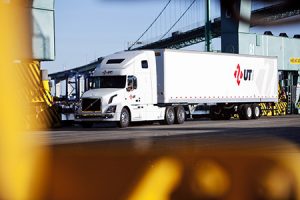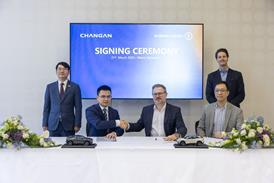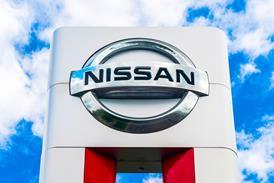The big players in automotive logistics are getting bigger after a record year for mergers and acquisitions, with middle players at particular risk of being subsumed. So will this trend continue?
 There has been a growing trend for consolidation in the third party logistics sector over the past few years, including among companies operating heavily in automotive and finished vehicle logistics. In 2015, a number of notable acquisitions played out, including Penske Logistics’ takeover of Transfreight North America, the purchase of UTi Worldwide by Danish outfit DSV, and Gefco’s takeover of Dutch freight forwarder IJS Global. XPO Logistics, meanwhile, has been on a buying spree, with 2015 most significant as it took over France-based Norbert Dentressangle and US-based Con-way.
There has been a growing trend for consolidation in the third party logistics sector over the past few years, including among companies operating heavily in automotive and finished vehicle logistics. In 2015, a number of notable acquisitions played out, including Penske Logistics’ takeover of Transfreight North America, the purchase of UTi Worldwide by Danish outfit DSV, and Gefco’s takeover of Dutch freight forwarder IJS Global. XPO Logistics, meanwhile, has been on a buying spree, with 2015 most significant as it took over France-based Norbert Dentressangle and US-based Con-way.
Finished vehicle logistics has also seen a number of mergers. In the US, Jack Cooper has swallowed up several big competitors to become the largest car carrier in the country by some margin. In Europe, there has been notable consolidation among carriers in Italy, Spain and the UK. Recently, British Car Auctions took over Eddie Stobart’s car haulage division in the UK, while Groupe CAT acquired a fleet of trucks from WWL in Germany.
In the broader logistics sector, FedEx is still embroiled in its ongoing takeover of TNT, and recently the European Union signalled that it would not prevent the move, unlike a prior takeover attempt by UPS over TNT.
The question among many providers and OEMs is whether this pace of acquisitions will continue or abate. With continuing cost, competitive and technological pressure, not to mention the need for larger, higher scale operations, many observers believe that the industry may have only just begun its consolidation process.
Still room to combineA recent quarterly analysis report of global deal activity in the transport and logistics industry carried out by PwC US reveals that 2015 was a record year for mergers and acquisitions, with deals worth $172.7 billion, compared to $87 billion in 2014.
Ben Hartford, senior equity research analyst at asset management firm Robert W Baird & Co, believes the consolidation trend within the logistics sector is being driven by providers’ desire to offer integrated services to customers. 3PLs are increasingly focused on building capabilities to provide a one-stop shop for customers in an environment where shippers are increasingly shifting towards fewer core logistics providers.
“Automotive logistics is specifically attractive because auto production has been more stable than broader industrial trends,” says Hartford. “That said, some recent acquisitions of companies concentrated in auto logistics are likely more coincidental to broader industry consolidation – for example, DSV’s purchase of UTi Worldwide, which derives around 10-15% of its business from automotive.”
 Thomas Blank, European managing director at Hong Kong-based Kerry Logistics, who recently joined the company from Agility Logistics, believes that what makes automotive logistics attractive to investors is the potential for value-added services and higher-than-average returns, compared to other sectors. He also points out that the mainstream logistics sector, including freight forwarding, has already gone through massive consolidation over the past 15 years, so targets for takeover with an interesting business model are rare.
Thomas Blank, European managing director at Hong Kong-based Kerry Logistics, who recently joined the company from Agility Logistics, believes that what makes automotive logistics attractive to investors is the potential for value-added services and higher-than-average returns, compared to other sectors. He also points out that the mainstream logistics sector, including freight forwarding, has already gone through massive consolidation over the past 15 years, so targets for takeover with an interesting business model are rare.
Andrea Conti, director of finished vehicle activities at Gefco Group, agrees that the main reason for consolidation of the automotive logistics market is the need for logistics providers to align with their clients’ wish to expand on a global scale. Conti himself used to be president of Mercurio Group, an Italian vehicle logistics firm that also had investments in India, which Gefco took control of in 2011. “Automotive companies are always looking to conquer new markets and reduce costs, whether it would be in developed countries like the EU or developing countries like Mexico,” says Conti.
“Automotive logistics providers are constantly evolving and accompanying the trends of the automotive market – merging with or acquiring another 3PL allows us to offer more flexibility and agility to our clients.”
Rob Choy, global vice-president of automotive at UTi Worldwide and member of the newly-combined UTi and DSV automotive expert team, agrees that a trend for consolidation has been evident in the broader logistics industry for some time. “Our industry is still quite fragmented, with the top players each owning less than 10% of the overall logistics market and a very long tail of competitors. So, the competition is intense in all segments and geographies, which ensures a competitive rate for our clients,” he says.
“Clients also play a role in accelerating this consolidation trend as we see many large OEMs and parts suppliers looking to reduce their provider base and establish longer term, more strategic partnerships to best leverage their spend and reduce the cost of managing dozens of providers,” Choy adds.
 "Automotive logistics is specifically attractive because auto production has been more stable than [other industries]. That said, some recent acquisitions... are likely more coincidental to broader industry consolidation." - Ben Hartford, Robert W Baird & Co
"Automotive logistics is specifically attractive because auto production has been more stable than [other industries]. That said, some recent acquisitions... are likely more coincidental to broader industry consolidation." - Ben Hartford, Robert W Baird & Co
The need to invest and develop new technologies may also be a driver in consolidation among logistics providers. Marc Althen, president at Penske Logistics, points out that some smaller, regional transport fleets might be falling behind the curve, particularly those that provide inbound material flow to OEMs. “[Automotive logistics providers] may not have invested in technology and/or equipment and aren’t able to scale out their operations to remain competitive in the marketplace,” he says. “Transfreight was at the point where a large investment was needed across the board, or its other option was to merge with a company like Penske.”
Brad Jacobs, chief executive officer at XPO, has indicated that the need to scale and compete with new technologies, along with the potential to reduce redundant costs, has been part of the driving force for the company’s blistering pace of investment. Speaking at the 2015 Automotive Logistics Conference in Detroit, he pointed to the need to reduce millions of dollars in inefficient back office and administration areas, and reinvest that money in research and development, including better IT systems.
Gaining global footprintsPerspectives on the merits and disadvantages of consolidation in automotive logistics vary. While carmakers have tended to use larger logistics companies because of their scale and flexibility, they also look to smaller firms to counterbalance the bigger players, or to offer niche services. Some executives fear that if companies become too large, they could start calling the shots or be inflexible to changing demands, or that an OEM or tier supplier would not receive the type of personalised service it might expect from a smaller company.
For analyst Ben Hartford, consolidation ultimately drives improved costs and service provision through increased density and scale, and its ability to eliminate duplication of operations. However, in the short term, he warns that company integrations can distract from customer focus and impede service, if growth is too rapid. While he admits consolidation should improve service and cost overall, he thinks subgroups of logistics providers will potentially be displaced and extra costs may even be generated.
At Penske, Marc Althen suggests that while the advantages of consolidation in the automotive logistics sector are many for 3PLs, they can result in higher service rates. “Consolidated companies can provide the customer with a larger global footprint, access to historical data and best practices, and a more diverse customer base,” he says. “However, one disadvantage is that shippers [such as OEMs and tier suppliers] may end up paying a fraction more for services.”
Kerry’s Thomas Blank says the main advantage of consolidation is the creation of companies that can offer a broader range of end-to-end supply chain services. “The disadvantage is that you will be confronted with very large organisations that may no longer offer the flexibility and adaptability of the smaller niche players.”
Andrea Conti claims the consolidation of Gefco’s network has allowed the company’s clients to benefit from international expertise, process and quality standards. As well as making recent acquisitions, Gefco was the subject of a takeover in 2012, when Russian Railways bought a majority stake in it from PSA Peugeot Citroën. “The global economy is leading to a global competition, where the number of major logistics providers able to manage an international supply chain from A to Z is probably less than the fingers we have on our hands,” he says. “This tight competition leads to an increase of standards among the major lead logistics providers.
“Acquiring companies such as IJS Global in October 2015 has allowed us to secure the quality of standard we offer throughout the world,” he adds.
René Falch Olesen, chief commercial officer at DSV and a member of the UTi and DSV automotive expert team alongside Rob Choy, is confident that the recent merger will provide advantages to the company’s clients in the automotive sector. He says larger logistics organisations are able to offer greater scale and capabilities to OEMs and suppliers, who are always looking for new ways to drive more value across their supply chain network. “The key is ensuring that these larger logistics organisations continue to stay client-focused, nimble and innovative,” he adds.
Aiming for stabilityPenske’s Marc Althen believes the trend for increasing consolidation in the automotive logistics sector will continue for the foreseeable future. This is partly because smaller regional companies are being asked to do more, which, he argues, requires investment in fleets and technology that many can’t afford.
“Consolidation could serve as an alternative to making these investments,” he says.
 "The classic middle segment will be eroded further and further. A logistics industry with only a few dominant players is like a carmaker that offers cars only in two colours." - Thomas Blank, Kerry Logistics
"The classic middle segment will be eroded further and further. A logistics industry with only a few dominant players is like a carmaker that offers cars only in two colours." - Thomas Blank, Kerry Logistics
Business sustainability is also a question among smaller operators, suggests Althen. Executives who started their businesses 20 years ago may now be looking to retire. Without a strong succession plan, many end up selling the company.
Thomas Blank agrees that the recent spate of merger and takeover activity will continue, especially as he sees further scope for logistics outsourcing among carmakers and tier one suppliers. “So there is an organic market growth within that industry rather than the cut-throat fight for market share in other segments,” he says.
DSV/UTi’s Rob Choy also thinks the consolidation trend will continue in the industry; most mature industries end up with three to five dominant companies and a handful of niche specialists, he points out. However, he says there is still a long way to go in the automotive logistics sector, with considerable room to improve economies of scale.
“There is a level of efficiency and cost competitiveness that you have when you have scale, especially in the air and sea freight forwarding markets. Without the scale and density in key trade lanes, it becomes harder to provide the competitive rates and frequency of service required by clients,” he says.
Short-term pain, long-term gainThomas Blank believes consolidation will ultimately lead to the dominance of a few big players who will be able to better deal with the high risks associated with large-scale industrial contracts. However, he also predicts this will occur alongside an ongoing search for even more embedded service and value propositions from niche providers.
“A balance would be nice, but looking at the freight forwarding sector, that is no longer the case. A few, very large companies are then followed by many, much smaller ones,” he says. “The classic middle segment will be eroded further and further. A logistics industry with only a few dominant players is like a carmaker that offers cars only in two colours.”
 Gefco’s Conti also believes the number of logistics providers in the automotive segment will reduce. In the short term, logistics providers must focus on the efficiency and excellence of their service to clients. In the long term, he argues, lead logistics providers will increasingly turn to fourth party logistics (4PL) solutions that allow the flexibility and resilience global logistics requires.
Gefco’s Conti also believes the number of logistics providers in the automotive segment will reduce. In the short term, logistics providers must focus on the efficiency and excellence of their service to clients. In the long term, he argues, lead logistics providers will increasingly turn to fourth party logistics (4PL) solutions that allow the flexibility and resilience global logistics requires.
“Gefco has begun this transition and is already offering 4PL solutions, for example with General Motors, for which we have been managing the supply chain in Europe since 2012,” he adds.
Ben Hartford warns that consolidation in the short term can create service disruptions while systems and processes are being integrated, although ultimately he believes such combinations lead to better workflows, IT capabilities and data analytics.
DSV’s Olesen agrees that increased consolidation could potentially result in confusion and disruption for clients in the short term if integration is not handled effectively. Although he argues DSV has a strong track record of successfully integrating acquisitions, the company still recognises that each one is unique, leading it to look for ways to improve each time and minimise any disruptions to clients.
“Long term, I believe the automotive logistics sector will become much stronger and more sustainable as a whole, with the ability for the top companies to deliver a high-quality service and broader supply chain logistics capabilities, which allows our clients to focus on their core business of designing, manufacturing, and selling vehicles and parts,” he adds.
Topics
- 3PLs
- acquisitions
- asia
- Asia
- Asia
- British Car Auctions
- consolidation
- Con-Way
- Dentressangle
- DSV
- DSV
- Eddie Stobart
- Europe
- europe
- features
- Fedex
- Fedex
- Gefco
- General Motors
- GM
- GM
- Groupe Cat
- IJS
- Integrated LSPs
- Jack Cooper
- LSPs
- Mercurio
- mergers
- Norbert
- north america
- North America
- Penske
- service providers
- Sustainability
- TNT
- Transfreight
- UPS
- UPS
- UTi
- WWL
- XPO




































